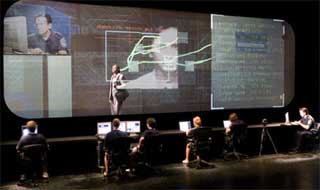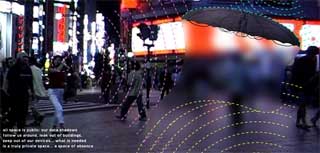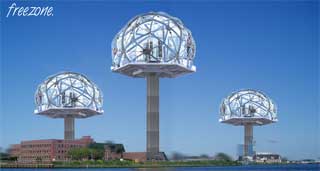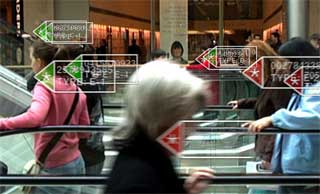The Super Vision performance (via Grand Text Auto), by the Builders Association and dbox, was presented last week at ISEA and it looks taps right into my interests of the moment (which are roughly about artists/hackers’ guerilla tactics to re-gain a sense of privacy in public space.)
Even before we are born, our personal electronic data begins to accumulate and to circulate. From our first sonogram, to birth certificates, academic records, dental records, credit card purchases, passports, and emails – as we grow, our “data body� grows with us, and becomes an integral part of our identity. In the age of information, we have come to accept, allow, and depend upon this new identity. How do we relate to the growing cloud of data that surrounds us and others?
Super Vision explores the changing nature of our relationship to living in a post-private society where personal electronic information is constantly collected and distributed. These bodies exist in a “data space� which remains mostly invisible. Super Vision makes that space visible.

SUPER VISION tells three stories:
1. As he crosses borders, a traveler gradually is forced to reveal all of his personal information, until his identity becomes transparent, with no part of his life left outside the bounds of dataveillance.
2. As a woman tries to digitally archive her Grandmother’s past, the grandmother slips into senility. The woman is left to discover what remains of her Grandmother’s life – and her own – outside the realm of data.
3. A father covertly exploits his young son’s personal data to meet the demands of the family’s lifestyle. This ploy escalates beyond control, until he is compelled to disappear. His wife and son are left with a starkly diminished data portrait, and his escape is shadowed by the long reach of the datasphere.
The artists will perform again on Thu–Sat, Aug 17–19 at the Yerba Buena, San Francisco.
Reading about this work made me think about a couple of projects that i’ll introduce with a quote from Futurologist Ian Pearson: “[In the future] there will be chips all over the high street relaying information and you will be bombarded with digital information everywhere you go,” said Pearson. “You will need a digital bubble force field — a shield that lets through what you want and blocks everything else.” (via)

First project is the floatable jellyfish-like vessels, by Usman Haque. The vessels would drift around cities to create ephemeral zones of truly private space: an absence of phone calls, emails, access of GPS devices, TV broadcasts, wireless networks and other microwave emissions. They can also provide shielding from the gaze surveillance systems.

A second project is Freezone. British artist Stanza imagined that information free zones could become the holiday destination of the future. All mobile phones, passports, id cards or chips would be left outside the pod.
Katherine Moriwaki has also explored the data that follows us like a shadow with Recoil. Powerful magnets sewed into suits allow the wearer creates a data-free zone, by erasing the data contained in memory devices like credit cards. These garments can also serve to heighten awareness in the wearer and others as to the high penetration of digital technologies into our everyday lives and reasserts awareness of bodily presence in the environment.

Last work that sprung to my mind was Chris Oakley‘s video The Catalogue which envisions humanity as a series of trackable units whose value is defined by their spending capacity and future needs.
